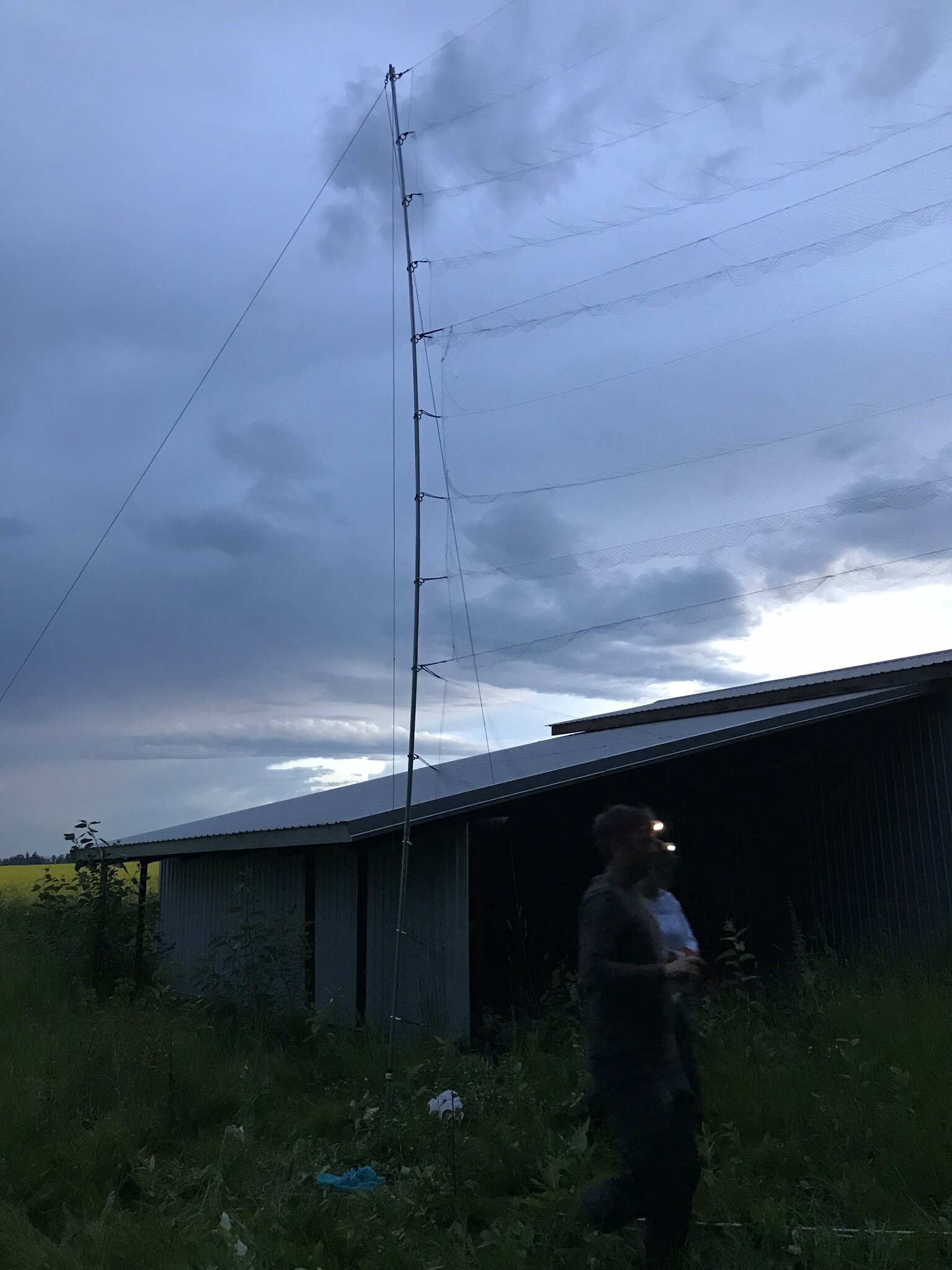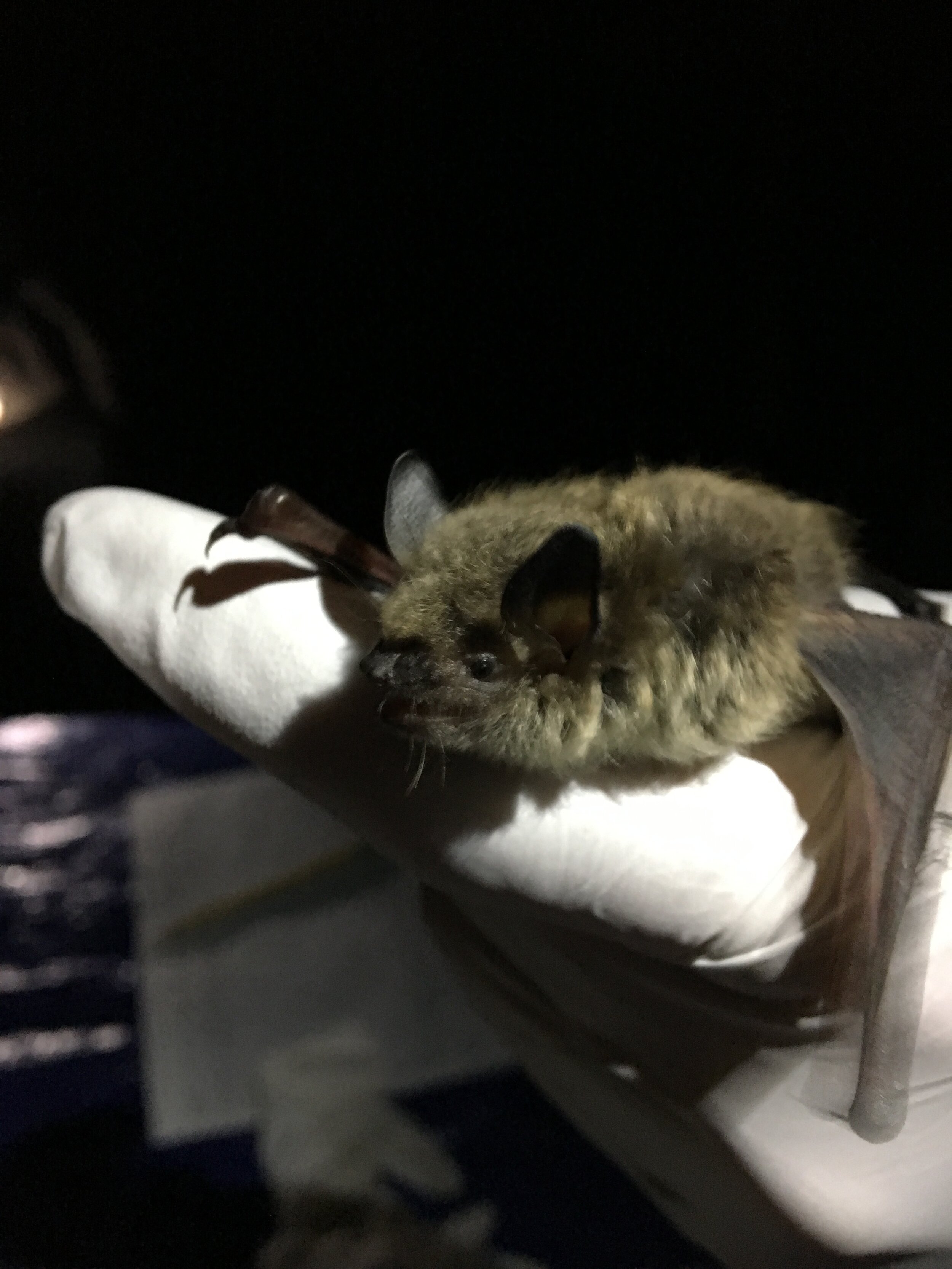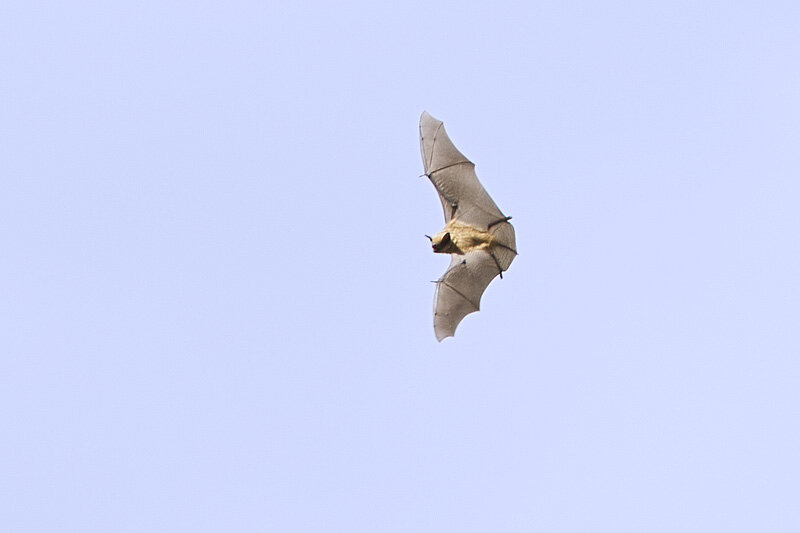At EALT, we have a lot to get done with not a lot of time, people, or resources. That is why we rely heavily on volunteers. Earlier this summer we wrote about the SCiP interns who helped out over the past year, funded by SCiP internship program, offered by Volunteer Alberta. During the past winter, had a wide variety of SCiP interns help us with tasks ranging from social media posts to identifying birds in recordings. Over the summer, EALT had two more interns join us – this time for bat monitoring!
Photo Credit: Cory Olson
What are we monitoring?
The surveys done by our interns had several parts.
Exit survey
Following protocols outlined by the Alberta Community Bat Program, Interns set up near a bat box suspected of being occupied by roosting bats at sunset, and watched for around an hour to count how many bats flew out of the roost. This gives us an idea of how many bats use the roost, and may indicate whether a roost is used by an entire colony or just a couple of bats. To be most effective, interns surveyed boxes several times to see if there were more bats after the pups from this year began flying.
Bat Guano collection
Following protocols outlined by the Alberta Community bat program, interns collected a sample of bat guano. Guano is a scientific term for bat poop! Why would we collect that you might ask? Bat poop is used for DNA analysis to identify which species of bat were using the bat box. This is very accurate but it takes a while!
Recording of bat calls to identify species
We used an Echo Touch meter to get a rough idea of what species were present. This device connects with an app on a phone or tablet and records the sounds created by bats, and makes a rough guess as to their species. This is not as accurate but it produces fast results!
Bat poop underneath a bat box. Photo Credit: Patty Klak
Other Monitoring
EALT staff have also been busy with bats! We got to try out two other types of bat monitoring to support research done by the Alberta Community Bat Program.
Driving Transects and Passive Bat Detection
EALT partnered with the Community Bat Foundation and the Nature Conservancy of Canada to do some monitoring of bat echolocation at Hicks and Golden Ranches Conservation Lands – this involved two separate activities. First, we mounted an echolocation detector on a tall pole, and left one at each site for about one week. Then we took the devices down, attached them to the top of a vehicle, and drove a pre-chosen route along back country roads at 30 km/hr, recording as we went. This should mean that we kept encountering new bats as we drove along.
This type of monitoring is another that gets accurate results but requires time spent on analyses, so we don’t yet know what species were discovered. We do know that there were many bats present though – the devices were blinking away!
Mist Netting
Once those transects were over, EALT staff got to try out a very fun activity – mist netting bats! This worked a lot like mist netting birds, where a variety of sizes of fine net were placed at intervals at Boisvert’s Greenwoods by staff from the Alberta Community Bat Program. After several hours of waiting, we were very excited to catch two Little Brown Bats and, a Northern Flying Squirrel! Several measurements were taken of the bats, and then they were released. No measurements were needed from the squirrel, though we were pretty excited to see him.
Little Brown Bat. Photo Credit: Robert Benner
What did we learn?
A lot of the results will take some time to analyze, but the echo touch meter suggested that we found Little Brown Bats and Big Brown Bats. There may be others as well, but we will have to wait to hear about the results of DNA analyses to be sure. It is exciting to learn that there are Little Brown Bats on our lands, because this species is endangered in Canada.
We also found that most of our boxes are used by just a couple bats in an evening – except for Glory Hills that is! A whole colony appears to be using one of the boxes there, with 50 bats found one night and 66 on another night! Wow!
Why are we monitoring bats?
Bats face lots of issues – habitat loss, disease, even deliberate persecution. Being both nocturnal and very small, without deliberate monitoring we have no way of knowing how our bat populations are doing.
One primary concern for bats is White-nose Syndrome, which is caused by a fungus that is native to Europe, but was spread to the east coast of Canada by cave explorers. Since being introduced to North America in 2006, white nose has also spread to the west coast of Canada, and is spreading towards the central provinces. For now, our bats in Alberta are free of this disease, but we have every reason to believe it will make its way here.
Why is it a problem?
White-nose Syndrome infects hibernating bats and is irritating enough to wake them from hibernation. When they wake and go to look for food, there is none to be found, and they perish. Frequently White-nose Syndrome is killing 90% of bat populations as it spreads to new parts of North America, because bats here have no resistance to this disease.
Why be concerned?
Bats eat many pests, including mosquitoes, which can be vectors of disease as well as irritating. They also eat moths whose caterpillars are pests on agricultural crops and forests. While bat boxes and monitoring won’t fix White-nose Syndrome, they can relieve other stressors on bat populations. Read more about this virulent disease here.
Photo Credit: Gerald Romanchuk
What can I do?
Install a bat box if you live in an area where there are bats, such as near a natural area or ravine. But be patient – they may take a while to find the box.
Don’t harm bats! If unwanted bats are in your building, you can provide them with alternative habitat and exclude them from the building without harming them.
Learn more! See EALT’s page about bat boxes and the Alberta Community Bat program’s webpage for more information about bats!
We’re grateful for the SCiP program that provides great opportunities for students to gain experience, and supports non-profits such as EALT. Learn more about SCiP here, or subscribe to our volunteer Newsletter (remember to check the box) to hear about upcoming EALT opportunities, including SCiP internships.
Photo Credit: Gerald Romanchuk
Sources:
Alberta Community Bat Program Home Page. (2019) Retrieved from Alberta Community Bat Program: https://www.albertabats.ca/
Little Brown Bat. (2013). Retrieved from Hinterland Who's Who: http://www.hww.ca/en/wildlife/mammals/little-brown-bat.html
Little Brown Myotis (Myotis lucifugus), the Northern Myotis (Myotis septentrionalis), and the Tri-colored Bat (Perimyotis subflavus): recovery strategy 2018. (2018, December 21). Retrieved from Government of Canada- : https://www.canada.ca/en/environment-climate-change/services/species-risk-public-registry/recovery-strategies/little-brown-myotis-2018.html#toc9
Species Profile- Little Brown Myotis. (2011, November 19). Retrieved from Government of Canada- Species at Risk Registry: https://wildlife-species.canada.ca/species-risk-registry/species/speciesDetails_e.cfm?sid=1173
White Nose Syndrome . (2019). Retrieved from Government of Alberta: https://www.alberta.ca/white-nose-syndrome.aspx









